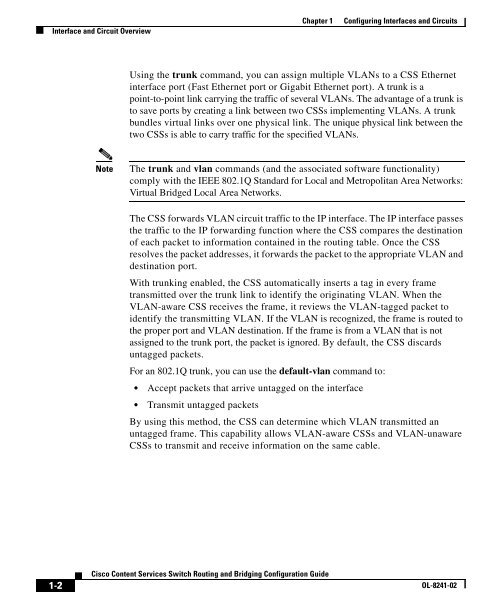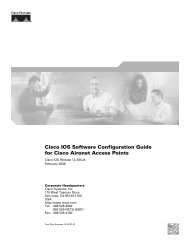Cisco Content Services Switch Routing and Bridging Configuration ...
Cisco Content Services Switch Routing and Bridging Configuration ...
Cisco Content Services Switch Routing and Bridging Configuration ...
You also want an ePaper? Increase the reach of your titles
YUMPU automatically turns print PDFs into web optimized ePapers that Google loves.
Interface <strong>and</strong> Circuit OverviewChapter 1Configuring Interfaces <strong>and</strong> CircuitsUsing the trunk comm<strong>and</strong>, you can assign multiple VLANs to a CSS Ethernetinterface port (Fast Ethernet port or Gigabit Ethernet port). A trunk is apoint-to-point link carrying the traffic of several VLANs. The advantage of a trunk isto save ports by creating a link between two CSSs implementing VLANs. A trunkbundles virtual links over one physical link. The unique physical link between thetwo CSSs is able to carry traffic for the specified VLANs.NoteThe trunk <strong>and</strong> vlan comm<strong>and</strong>s (<strong>and</strong> the associated software functionality)comply with the IEEE 802.1Q St<strong>and</strong>ard for Local <strong>and</strong> Metropolitan Area Networks:Virtual Bridged Local Area Networks.The CSS forwards VLAN circuit traffic to the IP interface. The IP interface passesthe traffic to the IP forwarding function where the CSS compares the destinationof each packet to information contained in the routing table. Once the CSSresolves the packet addresses, it forwards the packet to the appropriate VLAN <strong>and</strong>destination port.With trunking enabled, the CSS automatically inserts a tag in every frametransmitted over the trunk link to identify the originating VLAN. When theVLAN-aware CSS receives the frame, it reviews the VLAN-tagged packet toidentify the transmitting VLAN. If the VLAN is recognized, the frame is routed tothe proper port <strong>and</strong> VLAN destination. If the frame is from a VLAN that is notassigned to the trunk port, the packet is ignored. By default, the CSS discardsuntagged packets.For an 802.1Q trunk, you can use the default-vlan comm<strong>and</strong> to:• Accept packets that arrive untagged on the interface• Transmit untagged packetsBy using this method, the CSS can determine which VLAN transmitted anuntagged frame. This capability allows VLAN-aware CSSs <strong>and</strong> VLAN-unawareCSSs to transmit <strong>and</strong> receive information on the same cable.1-2<strong>Cisco</strong> <strong>Content</strong> <strong>Services</strong> <strong>Switch</strong> <strong>Routing</strong> <strong>and</strong> <strong>Bridging</strong> <strong>Configuration</strong> GuideOL-8241-02



